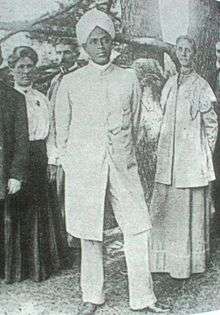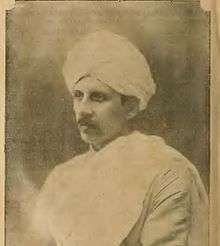Ponnambalam–Coomaraswamy family

The Ponnambalam-Coomaraswamy family (Tamil: பொன்னம்பலம் குமாரசுவாமி குடும்பம்) is a Sri Lankan Tamil Hindu family that was prominent in politics in former Ceylon former name of Sri Lanka from colonial era to 1972.[1] Many members received imperial honours such as knighthood by the British Crown.[2]
History
The Ponnambalam-Coomaraswamy family are mainly from Manipay, Jaffna and were of the Sri Lankan Vellalar caste.[3][4] They have been politcaly active since 18th century, with many having posts such as Mudaliyars, a title for Ceylonese officials used under the Colony governments of Ceylon.[5]
Arumuganathapillai Coomaraswamy, one of the earliest known member of the family was a Gate Mudaliyar, second highest Mudaliyar position. Arumuganathapillai rendered service to the British under the Kandyan Wars, in their attempt to gain control over the Kandy Kingdom.[2]
The family have also made noteworthy contributions. Ponnambalam Ramanathan founded the Parameshwara College, which was later used by Sri Lankan government to establish the University of Jaffna.[6] Sri Ponnambalam Vaneswarar Temple located in Colombo is also credited to be founded by the family.[7] Sri Kurinji Easware temple is a temple located in Kodaikanal, Tamil Nadu is credited to have been built by a European woman, Leelawathy Ramanathan, the wife of Ponnambalam Ramanathan.[8]
Furthermore have some of the family members contributed to literature. Ananda Coomaraswamy was a Metaphysist and Aesthetic, who widely contributed to bringing Indian art to the Western world and has contributed with many books on traditional Indian and Sinhalese art.[9][10]
Notable members of the family

- Arumugampillai Coomaraswamy (1783-1836), Gate Mudaliyar, Member of Legislative Council
- Sir Muthu Coomaraswamy CCS FRGS (1833-1879), Member of Legislative Council + Elizabeth Clay Beebe
- Ananda Coomaraswamy (1877-1947)
- Narada Coomaraswamy
- Ananda Coomaraswamy (1877-1947)
- Sellachchi Coomaraswamy + Arunachalam Ponnambalam (1814-1887), Mudaliyar of the Governor's Gate
- P. Coomaraswamy (1849-1906), Member of Legislative Council
- Sir Ponnambalam Ramanathan KCMG QC (1851-1930), Solicitor General of British Ceylon, Member of Legislative Council + Leelawathy Ramanathan (1870-1953)
- Sivagamasundari + S. Natesan, Member of Parliament, Member of State Council, Senator
- Sir Ponnambalam Arunachalam KCMG CCS (1853-1924), Member of Executive Council, Member of Legislative Council + Swarnambal Namasivayam
- Arunachalam Padmanabha
- Sir Arunachalam Mahadeva KCMG (1888-1969), Government Minister, Member of Legislative Council, Member of State Council, High Commissioner to India
- Balakumar Baku Mahadeva
- Arunachalam Ramanathan
- Pathmavathy Arunachalam + Sir S. Pararajasingam, Senator
- Pararajasingham Nadesan
- Lalithambikai (-2005) + M. Swaminathan
- D. M. Swaminathan (1945-), Member of Parliament, Governor of Western Province
- Sir Muthu Coomaraswamy CCS FRGS (1833-1879), Member of Legislative Council + Elizabeth Clay Beebe
See also
References
- ↑ "The Constitution of Sri Lanka: Chapter I - The People, the State and Sovereignity". 2014-05-31. Archived from the original on 2014-05-31. Retrieved 2017-10-02.
- 1 2 Wilson, A. Jeyaratnam (2000). Sri Lankan Tamil Nationalism: Its Origins and Development in the Nineteenth and Twentieth Centuries. UBC Press. ISBN 9780774807593.
- ↑ http://noolaham.net/project/19/1810/1810.pdf
- ↑ Welhengama, Gnanapala; Pillay, Nirmala (2014-03-05). The Rise of Tamil Separatism in Sri Lanka: From Communalism to Secession. Routledge. ISBN 9781135119713.
- ↑ Peebles, Patrick (2015-10-22). Historical Dictionary of Sri Lanka. Rowman & Littlefield. ISBN 9781442255852.
- ↑ "History - University of Jaffna". University of Jaffna. Retrieved 2017-10-02.
- ↑ Muttucumaraswamy, V. (1973). Founders of modern Ceylon (Sri Lanka): eminent Tamils. Uma Siva Pathippakam.
- ↑ "Honouring the Kurinji". The Hindu. 2015-05-04. ISSN 0971-751X. Retrieved 2017-10-02.
- ↑ MFA: South Asian Art. Archived from the original Archived 15 June 2010 at the Wayback Machine.
- ↑ Oldmeadow, Harry (2004). Journeys East: 20th Century Western Encounters with Eastern Religious Traditions. World Wisdom, Inc. ISBN 9780941532570.